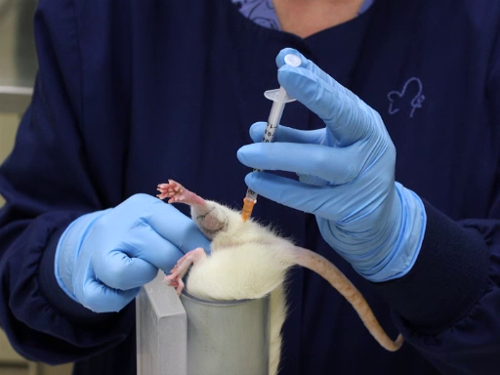화합물 투여 I
Overview
출처: 케이 스튜어트, RVT, RLATG, CMAR; 발레리 A. 슈뢰더, RVT, RLATG. 노틀담 대학교, IN
많은 연구 프로토콜은 물질을 동물에 주입해야 하므로, 전달 경로와 물질의 양을 정확하게 결정해야 한다. 마우스와 쥐에서 사용할 수있는 관리의 여러 경로가 있습니다. 어떤 경로를 사용하는 경로는 주입될 물질의 여러 요인에 의해 결정됩니다: 용액의 pH, 원하는 투여량에 필요한 부피, 용액의 점도. 물질이 잘못 투여되면 심각한 조직 손상이 발생할 수 있습니다. 이 비디오는 가장 일반적으로 사용되는 사출 경로에 대한 다양한 구속 방법과 기술적 세부 사항을 살펴봅니다.
Procedure
1. 피하 주입
- 한 손으로 구속 홀드를 통해 마우스를 수동으로 억제합니다. 일단 잡히면 마우스가 테이블이나 다른 보안 표면에 놓일 수 있습니다. 마우스 본문에 압력을 가하지 않도록 하십시오.
- 호흡을 손상시킬 수 있는 마우스의 과도한 무게를 피하기 위해 테이블에 손의 발 뒤꿈치를 놓습니다. 마우스는 또한 상용 장치에서 억제될 수 있다. 쥐의 경우 상용 구속 장치를 사용하는 것이 가장 좋습니다.
- 피부를 잡고 위로 당겨 피부 텐트를 만듭니다. 구속 장치를 사용하는 경우 상단의 슬롯을 통해 피부를 파악하려면 집게가 필요할 수 있습니다.
- 바늘을 척추에 평행하게 삽입하고 텐트의 피부 접기 의 바닥에 머리에서 멀리 지시합니다. 마우스의 두개골 뼈가 매우 얇기 때문에 두개골에 구멍이 발생할 가능성을 피하기 위해 머리에서 바늘을 직접 합니다. 쥐는 그들의 머리를 양육 하는 경향이 있다, 목 근육에 배치 될 주사를 일으킬 수 있는.
- 바늘 벨을 삽입하여 피부에
Application and Summary
References
- Turner, P.V., Pekow, C., Vasbinder, M. A. and Brabb, T. 2011. Administration of substances to laboratory animals: equipment and considerations, vehicle selection, and solution preparation. JAALAS. 50:5. 614-627.
- Shimizu, S. 2004. Routes of Administration in The Laboratory Mouse. Elsevier.
- Machholz, E., Mulder, G., Ruiz, C., Corning, B. F., Pritchett-Corning, K. R. 2012. Manual Restraint and Common Compound Administration Routes in Mice and Rats. J. Vis. Exp. (67), e2771, doi:10.3791/2771
- Turner, P. V., Brabb, T., Pekow, C., Vasbinder, M. A. 2011. Administration of substances to laboratory animals: routes of administration and factors to consider. JAALAS. 50, 600-613
Tags
건너뛰기...
이 컬렉션의 비디오:

Now Playing
화합물 투여 I
Lab Animal Research
100.4K Views

설치류 취급 및 통제 기술
Lab Animal Research
174.3K Views

실험실 기본 관리
Lab Animal Research
27.9K Views

사육 및 이유의 기초
Lab Animal Research
35.7K Views

설치류 식별 I
Lab Animal Research
54.7K Views

설치류 식별 II
Lab Animal Research
25.6K Views

화합물 투여 II
Lab Animal Research
34.9K Views

화합물 투여 III
Lab Animal Research
31.4K Views

화합물 투여 IV
Lab Animal Research
51.6K Views

혈액 채취 I
Lab Animal Research
171.5K Views

혈액 채취 II
Lab Animal Research
73.1K Views

마취 유도 및 유지
Lab Animal Research
50.4K Views

설치류 수술에 대한 고려 사항
Lab Animal Research
22.5K Views

진단 부검 및 조직 수확
Lab Animal Research
58.0K Views

멸균 조직 수확
Lab Animal Research
34.8K Views
Copyright © 2025 MyJoVE Corporation. 판권 소유



